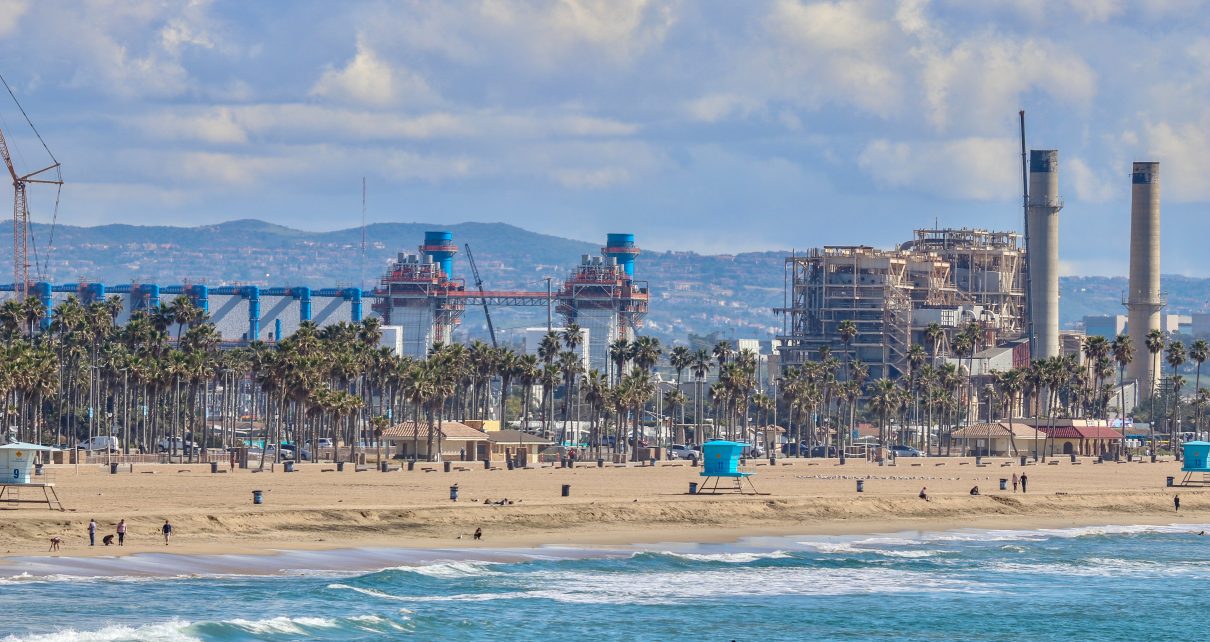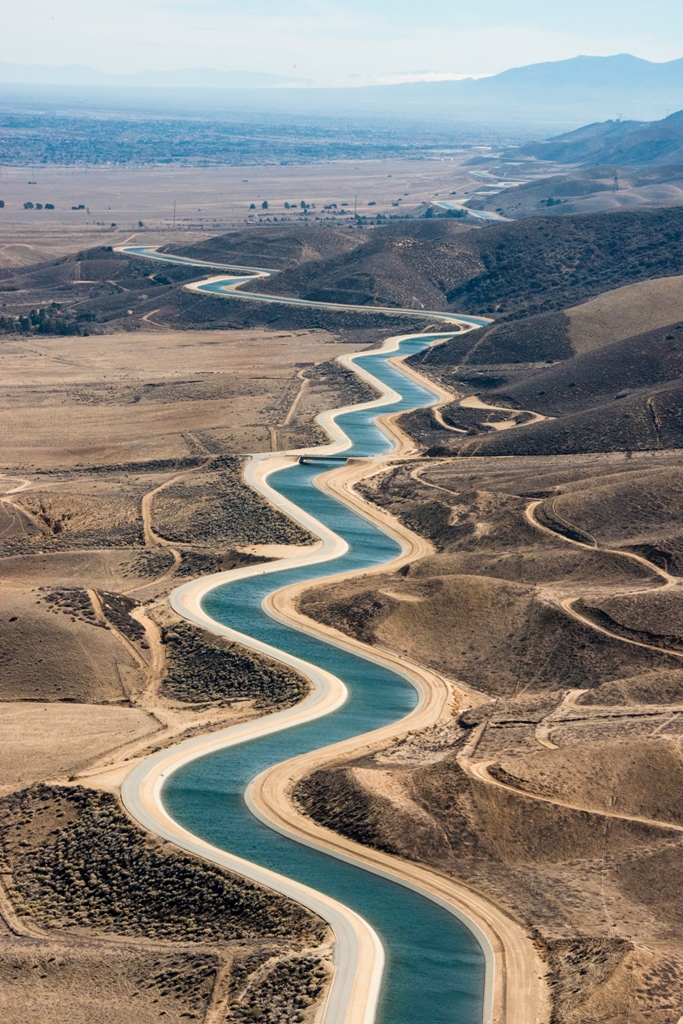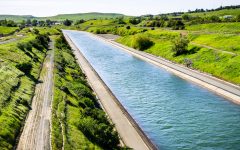
Southern California Desalination plant. (Photo: Shutterstock, KK Stock)
Ringside: Comparing the Delta Tunnel versus Desalination
Desalination offers a source of water that is local and impervious to disruptions in supply from other sources
By Edward Ring, February 1, 2024 6:57 am
 Debates over the efficacy of water projects often focus on the monthly cost to end users. For example, in May 2022, a few days before the California Coastal Commission voted unanimously to deny the final permit to build a desalination plant in Huntington Beach, the influential Los Angeles Times columnist Michael Hiltzik fretted that it “might drive up the average household water bill in Orange County by $3 to $6 per month.”
Debates over the efficacy of water projects often focus on the monthly cost to end users. For example, in May 2022, a few days before the California Coastal Commission voted unanimously to deny the final permit to build a desalination plant in Huntington Beach, the influential Los Angeles Times columnist Michael Hiltzik fretted that it “might drive up the average household water bill in Orange County by $3 to $6 per month.”
Is that all? People of all incomes spend that much money every week buying cases of bottled water, or, for that matter, $3 will get you one-half of a Big Mac burger. Up to $6 a month is a manageable cost, and in any case water districts have programs to alleviate these costs for qualifying low income households.
One of the biggest concerns about desalination projects is the financial cost to build them. Another frequently heard criticism is that they use too much energy. But as with all things, the relevant question is compared to what?
From this perspective, a relevant comparison is the estimated cost for the Huntington Beach Desalination plant versus the estimated cost for the proposed Delta Tunnel. We must bear in mind that the Delta Tunnel, if it is ever built, probably won’t add one drop to California’s water supply. Every acre foot that makes it through that tunnel will probably be one less acre foot that gets moved into the aqueducts from existing intakes on the southern edge of the Delta. But let’s pretend this water is truly additive. How does the cost of this tunnel compare to a desalination plant?
Rather than evaluate these costs based on the eventual monthly price hike to the consumer, which is a complex exercise fraught with subjectivity, it is revealing to examine a simpler metric. How much does it cost to build the project, divided by the amount of acre feet it is projected to supply per year? After all, most of what goes into monthly water bills is recovery of the massive costs incurred to build the storage, delivery and treatment infrastructure.
For the Huntington Beach proposal, calculating this ratio is straightforward. It was to be an ungraded twin to the Carlsbad plant, estimated to cost $1.4 billion to produce 55,000 acre-feet of fresh water per year. That’s a capital cost of $25,455 per acre foot of annual supply. What about the Delta Tunnel?
The most recent official estimate of the cost is $16 billion, an estimate which brings to mind California’s high speed rail project which was once projected to cost $30 billion, and now is estimated to cost over $130 billion – if it ever gets built. According to the Sierra Club, the inflation adjusted currently estimated cost for the Delta Tunnel is $56 billion. Let’s split the difference, slightly favoring the low estimate, and figure the Delta Tunnel can be built for $30 billion. What about the throughput?
These numbers can be found in a useful summary published in ENR California this past December. Drawing data from the just released final environmental impact report for the Delta Tunnel, it’s latest design is 44.6 miles long with an interior diameter of 36 feet and a pumping capacity that can range between 600 and 6,000 CFS, which equates to between 434,000 acre feet per year and 4.3 million acre feet per year. Quoting the California Dept. of Water Resources, the ENR report states the current one-tunnel design is “still planned to yield about 500,000 acre-ft of water per year.”
Let’s imagine this tunnel gets built at the absurdly optimistic low price of $16 billion. In that case, at a yield of 500,000 acre feet per year, that’s a capital cost of $32,000 per acre foot, 26 percent more than desalination. A best case scenario? Let’s go with a $30 billion construction cost and an average movement of 1 million acre feet per year. That’s still $30,000 per acre foot, clearly more than desalination. And with desalination, you’re not fighting for your allocation every year.
Concern about the energy cost to desalinate ocean water also doesn’t hold up when compared to the pumping energy needed for interbasin transfers such as via California’s remarkable state water project. Transporting water from south of the Sacramento-San Joaquin Delta all the way to Los Angeles requires six pump stations with a cumulative lift of nearly 3,300 feet. To move one million acre feet per year, the entire distance would require a continuous power input of approximately 400 megawatts, although some of that energy is recovered on the seaward side of the mountain as that water flows downhill into Los Angeles. The energy required to desalinate one million acre feet of fresh water from the ocean? Also 400 megawatts. There is a rough parity between the energy required to desalinate, and the energy required to move water from the Delta all they way south into Southern California.
When comparing the option of desalination with the option of the proposed Delta Tunnel, in terms of both financial cost and energy cost, desalination is a competitive option, if not clearly better. What is also clear about desalination in California is its potential to offer the final link in an integrated local water supply strategy that would put these megacities completely independent of imported water.
For example, the Orange County Water District, serving 2.5 million people, recycles 130,000 acre feet per year of wastewater, with projects underway to increase their capture and use of local baseflow and storm runoff to 210,000 acre feet per year. With capacious aquifers to store excess runoff in wet years, when these projects are completed they estimate their remaining import requirement to average only 50,000 acre feet per year, less than what the denied Huntington Beach desalination plant would have produced.
A similar story can be told for Los Angeles County, where projects that are either proposed or already in the works will bring their wastewater reuse up over 500,000 acre feet per year, with ongoing projects to harvest more local baseflow and stormwater expected to add another 550,000 acre feet per year. Depending on just how hard Los Angeles squeezes their residents with rationing, they are on track to be within 50,000 to 100,000 acre feet of being independent of imported water. Desalination could fill that gap.
Desalination offers a source of water that is local and impervious to disruptions in supply from other sources. It may not be the cheapest source of new water, but neither is the Delta Tunnel. There are proposals for fish friendly projects to withdraw additional millions of acre feet from the Delta during winter storms that could cost far less. Responsible regulators would investigate these options before saddling California taxpayers with another make-work financial debacle.
California’s farmers and urban residents have a shared interest in water abundance and a resilient infrastructure that supplies water from diverse sources. They should work together to advocate for common sense projects that achieve both of these objectives.
- Ringside: CA GOP Just Blew $46 Million for Nothing – Here’s How They Can Avoid Repeating That Mistake in 2026 - December 24, 2025
- Ringside: Will the Delta Pumps Operate at Capacity this Winter? - December 18, 2025
- Ringside: Will Advocates for More Water Supply Projects Find Unity? - December 11, 2025





The fact that desalination offers a source of water that is local and impervious to disruptions in supply from other sources is one of the major reasons that the criminal Democrat mafia and their RINO cronies oppose it and try to make it as difficult as possible to build desalination plants? Creating water scarcity is one of their main ways of controlling local governments and Californians?
And then there’s the BILLIONS of gallons of water that fell on Los Angeles last night, most of which washed out to Santa Monica Bay to pollute it for the next two weeks….
El Lay has always been run by morons….
Here’s Gavin Newsom’s legacy of WASTED WATER in real-time….
https://weather.com/news/weather/video/satisfying-watch-as-water-flows-from-oroville-dam
Satisfying??? REALLY poor optics IBM/Weather Company…. that’s a CRIMINAL action being taken right there as all those precious gallons go where??? Out to sea???
Obviously a fish is more important than people.
Desalination is a must for the future of California.
Offering suggestions that will go nowhere:
1) somehow reign in the California Coastal Commission to become reasonable. The CCC is detrimental to a healthy California environment.
2) proposal of a plan to fund ? think tanks ? universities ? public to develop cost effective, environmentally safe desalination plants; possible that multi designs will work. { designs must be not be eyesores like Carlsbad }
3) somehow awaken the people and the government to get their heads where the sunshines. Sites Reservoir.
Brian Anderson – (AI quote from Google:) “The Sites Reservoir project in Northern California was first proposed in the 1950s as a way to store excess surface water from across California. The project was re-proposed several times over the years, including in the 1980s as part of the State Water Project, but was abandoned. Interest in the reservoir was renewed in the 2000s due to climate change and droughts, and in 2023, construction was expected to begin.” Amazing. The Sites Reservoir was planned over 70 years ago. How incompetent is CA.